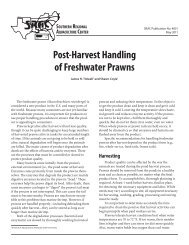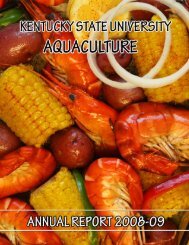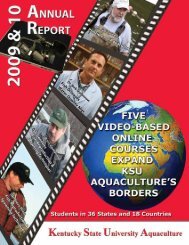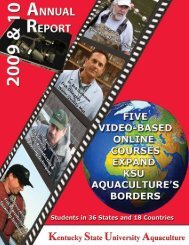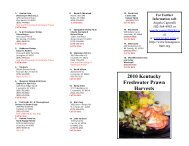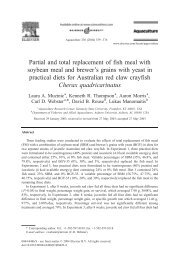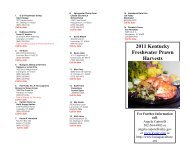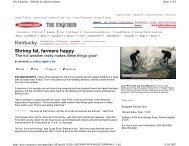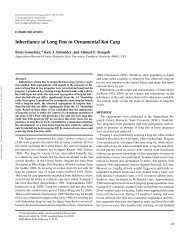Aquatic Weed Control in Ponds - Aquaculture at Kentucky State ...
Aquatic Weed Control in Ponds - Aquaculture at Kentucky State ...
Aquatic Weed Control in Ponds - Aquaculture at Kentucky State ...
Create successful ePaper yourself
Turn your PDF publications into a flip-book with our unique Google optimized e-Paper software.
form, but the liquid is most commonlyused. The copper <strong>in</strong> these herbicides isbound <strong>in</strong> organic complexes so th<strong>at</strong> thecopper will not precipit<strong>at</strong>e out ofsolution as rapidly as uncomplexedcopper <strong>in</strong> hard, alkal<strong>in</strong>e w<strong>at</strong>ers. Cutr<strong>in</strong>e-Plus, for example, has a prolongedeffectiveness because its chel<strong>at</strong><strong>in</strong>g agent,ethanolam<strong>in</strong>e, decomposes slowly <strong>in</strong>sunlight. Although chel<strong>at</strong>ed copperherbicides usually are more effectivethan copper sulf<strong>at</strong>e, they areconsiderably more expensive to use.The table on page 21 of this booklet liststhe aqu<strong>at</strong>ic weeds controlled by each ofthe chel<strong>at</strong>ed copper compounds. Copperherbicides have a reput<strong>at</strong>ion foreffectively kill<strong>in</strong>g algae <strong>in</strong>clud<strong>in</strong>gphytoplankton, some filamentous algaeand Chara (musk grass) which is also analgae. However, Cutr<strong>in</strong>e-Ultra isspecially designed to kill Pithophorawith a penetr<strong>at</strong><strong>in</strong>g surfactant. AndKomeen, Pondmaster, Nautique, andCapta<strong>in</strong>, unlike many other chel<strong>at</strong>edcoppers, are able to control higheraqu<strong>at</strong>ic plants like Najas, coontail,Elodea and sago pondweed.Additionally, chel<strong>at</strong>ed coppersare often comb<strong>in</strong>ed with other herbicidessuch as Reward, Aqu<strong>at</strong>hol, or Sonar toenhance their effectiveness, and <strong>in</strong> somecases, reduce the amount needed of bothherbicides.Diqu<strong>at</strong> (Reward, <strong>Weed</strong>tr<strong>in</strong>e D).Diqu<strong>at</strong> is sold as a liquid conta<strong>in</strong><strong>in</strong>g 2pounds active <strong>in</strong>gredient per gallon. It isa wide-spectrum herbicide and willcontrol most filamentous algae <strong>in</strong>clud<strong>in</strong>gPithophora spp. and Chara spp.,submersed weeds such as Najas spp. andcoontail, and can be mixed with asurfactant and sprayed to controlemergent weeds such as c<strong>at</strong>tail. Diqu<strong>at</strong>should not be used <strong>in</strong> muddy w<strong>at</strong>er andmud should not be stirred up dur<strong>in</strong>gapplic<strong>at</strong>ion because diqu<strong>at</strong> will b<strong>in</strong>dtightly with clay particles suspended <strong>in</strong>the w<strong>at</strong>er render<strong>in</strong>g the herbicide<strong>in</strong>effective <strong>at</strong> controll<strong>in</strong>g plants grow<strong>in</strong>gbene<strong>at</strong>h the surface. Diqu<strong>at</strong> should beapplied on a sunny day to activelygrow<strong>in</strong>g weeds. Only 1 / 3 to 1 / 2 of thepond w<strong>at</strong>er area should be tre<strong>at</strong>ed <strong>at</strong> onetime with a 14-day <strong>in</strong>terval betweentre<strong>at</strong>ments. A 14-day withdrawal periodis required by law after diqu<strong>at</strong> use beforetre<strong>at</strong>ed w<strong>at</strong>er can be used for animalconsumption, swimm<strong>in</strong>g, spray<strong>in</strong>g,irrig<strong>at</strong>ion or dr<strong>in</strong>k<strong>in</strong>g.Endothall, dipotassium salt(Aqu<strong>at</strong>hol, Aqu<strong>at</strong>hol K, Aqu<strong>at</strong>holSuper K). The dipotassium salt ofendothall is available <strong>in</strong> liquid (Aqu<strong>at</strong>holK) or granular (Aqu<strong>at</strong>hol) form. It willnot kill algae but will control a widevariety of submersed higher plants,<strong>in</strong>clud<strong>in</strong>g Najas spp., coontail, andfanwort. The granular formul<strong>at</strong>ion isrel<strong>at</strong>ively expensive, but is particularlyeffective on Najas spp. Dipotassium saltof endothall is a contact killer. It issprayed onto or <strong>in</strong>jected below the w<strong>at</strong>ersurface and can be sprayed <strong>at</strong> highconcentr<strong>at</strong>ions directly on exposedweeds. For best results, w<strong>at</strong>ertemper<strong>at</strong>ures should be 65º F or above.When w<strong>at</strong>er temper<strong>at</strong>ures are high andan <strong>in</strong>creased danger of dissolved oxygendepletion exists, this herbicide should beapplied to 1 / 3 to 1 / 2 of the pond pertre<strong>at</strong>ment with a 5 to 7 day <strong>in</strong>tervalbetween tre<strong>at</strong>ment applic<strong>at</strong>ions.W<strong>at</strong>er tre<strong>at</strong>ed with granularAqu<strong>at</strong>hol must not be used for irrig<strong>at</strong>ionor for agricultural sprays on food cropsor for domestic purposes with<strong>in</strong> 7 daysof tre<strong>at</strong>ment. More detailed restrictionsexist for Aqu<strong>at</strong>hol K. It may not be usedfor the above mentioned purposes aswell as for w<strong>at</strong>er<strong>in</strong>g livestock for 7 daysafter apply<strong>in</strong>g it up to 0.5 ppm; for 1414



